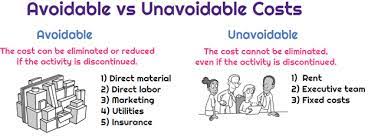
Difference Between Avoidable Costs And Unavoidable Costs.Avoidable and unavoidable costs.Sometimes the terms ‘avoidable’ and ” costs are used instead of relevant and irrelevant costs. Avoidable costs are those costs that may be saved by not adopting a given alternative, whereas unavoidable costs cannot be saved. Therefore only avoidable costs are relevant for decision-making purposes. Consider the example that we used to illustrate relevant and irrelevant costs. The material costs of £100 are unavoidable and irrelevant, but the conversion costs of 000 are avoidable and hence relevant. The decision rule is to accept those alternatives that generate revenues in excess of the avoidable costs.

If you want to go out in public, what do you absolutely have to do? There are many answers to that question. For example, you need to move. You need to get out of your house/apartment. You should also put on clothes. The need for clothing is unavoidable. The cost of clothing is then an unavoidable cost. You need to buy clothes if you want to go out in public. However, one clothing cost that can be avoided is spending money on something extravagant like expensive designer clothes. Therefore, there is a difference between essential and unavoidable costs and non-essential and avoidable costs. This is what we will discuss in greater detail throughout the lesson.
Definitions
An avoidable cost is a cost that is not incurred if the activity is not performed. For example, supply costs are avoidable costs. You can simply decide not to purchase the supplies and you will not incur any costs. These costs are often identified as variable costs , which vary based on output. If there is no production, there is no cost.
An unavoidable cost , on the other hand, is a cost that is still incurred even if the activity is not performed. For example, if a manufacturing plant closes, your avoidable costs (ie variable costs), such as materials or supplies, will be $0, but you still have to pay for idle equipment, property taxes, lease payments, etc. These costs are often considered fixed costs . Fixed costs are expenses that do not depend on production.
Difference Between Avoidable Costs And Unavoidable Costs
More Examples
Let’s imagine that you are the CEO of a company that produces widgets.
Some examples of your avoidable costs may include:
- The material that goes into the widget, such as metal, steel, aluminum, glass, etc. These costs can be avoided by simply not ordering them.
- Labor directly linked to the production of widgets. If production decreases or even goes to zero, labor costs can also be reduced to zero.
- Packaging is another avoidable expense. If you want to reduce the packaging costs to zero, you cannot package the widget or stop production.
Some examples of unavoidable costs may include:
- Equipment depreciation. Equipment is depreciated over its useful life. As the year progresses, depreciation expense is incurred.
- Lease payments and property taxes tied to the plant still need to be paid regardless of production.
- If the company has debt, the interest on the debt is an inescapable cost. Interest/principal payments must be paid regardless of production.
Lesson summary
There are two broad types of costs: avoidable costs and unavoidable costs. An avoidable cost is a cost that is not incurred if the activity is not performed. Examples include cost of labor, packaging, or materials. These costs are often identified as variable costs, which vary based on production. If there is no production, there is no cost.
An unavoidable cost is a cost that is still incurred even if the activity is not performed. Some examples include equipment depreciation, property taxes, lease payments, interest expense, etc. These costs are often considered fixed costs. The amount of spending does not depend on production.
Leave a Reply